The First 35
I truly cannot ask for more. How rare is that, how appropriate? What will I do with the next 35? With this support, I bet on myself to do good.
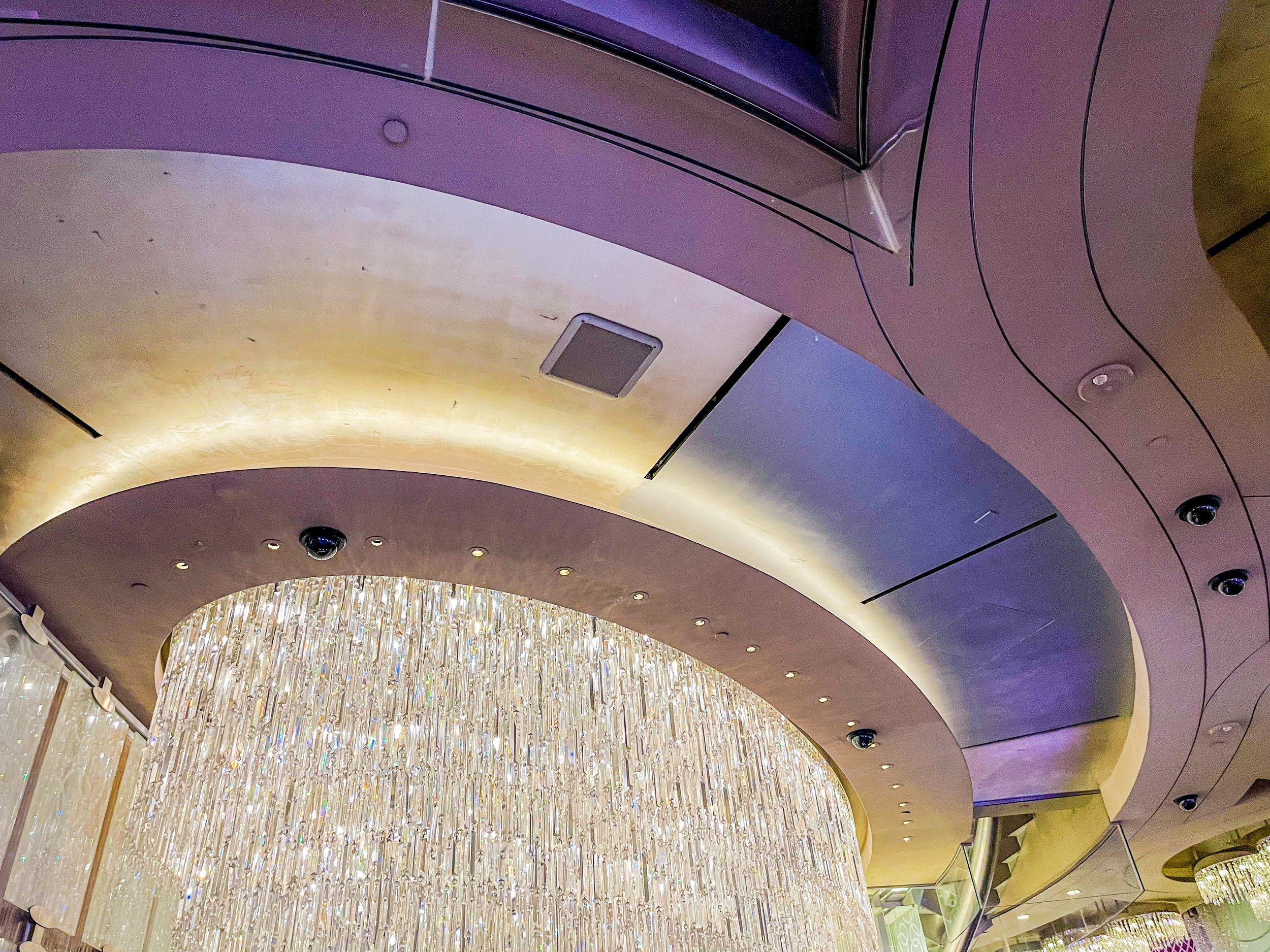
Looking up last night
I truly cannot ask for more. How rare is that, how appropriate? What will I do with the next 35? With this support, I bet on myself to do good.
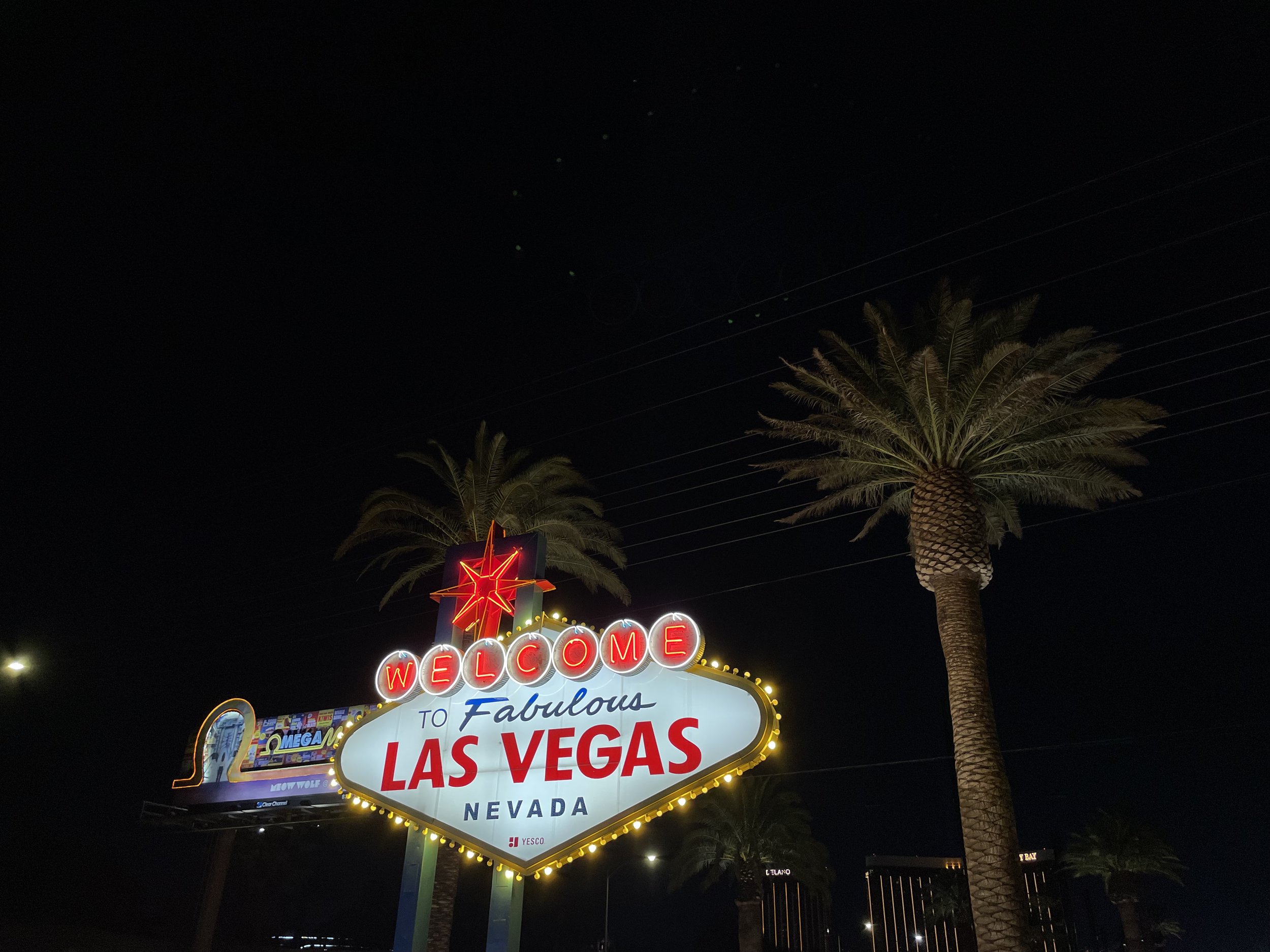
Is it not?

Do we know what they are here?
I often wonder about priorities. What are mine, what are those of the people I’m around, what are the world’s? Are people our priority, and more holistically, should they be? These are the difficult questions we need to answer.

Midnight Arctic vibes
Our experience in the Arctic was transformative. It reinforced lessons learned in Antarctica: the Earth is huge and magnificent. We live on a planet with an incredible diversity of life. And we are but one (albeit important) component of it all.
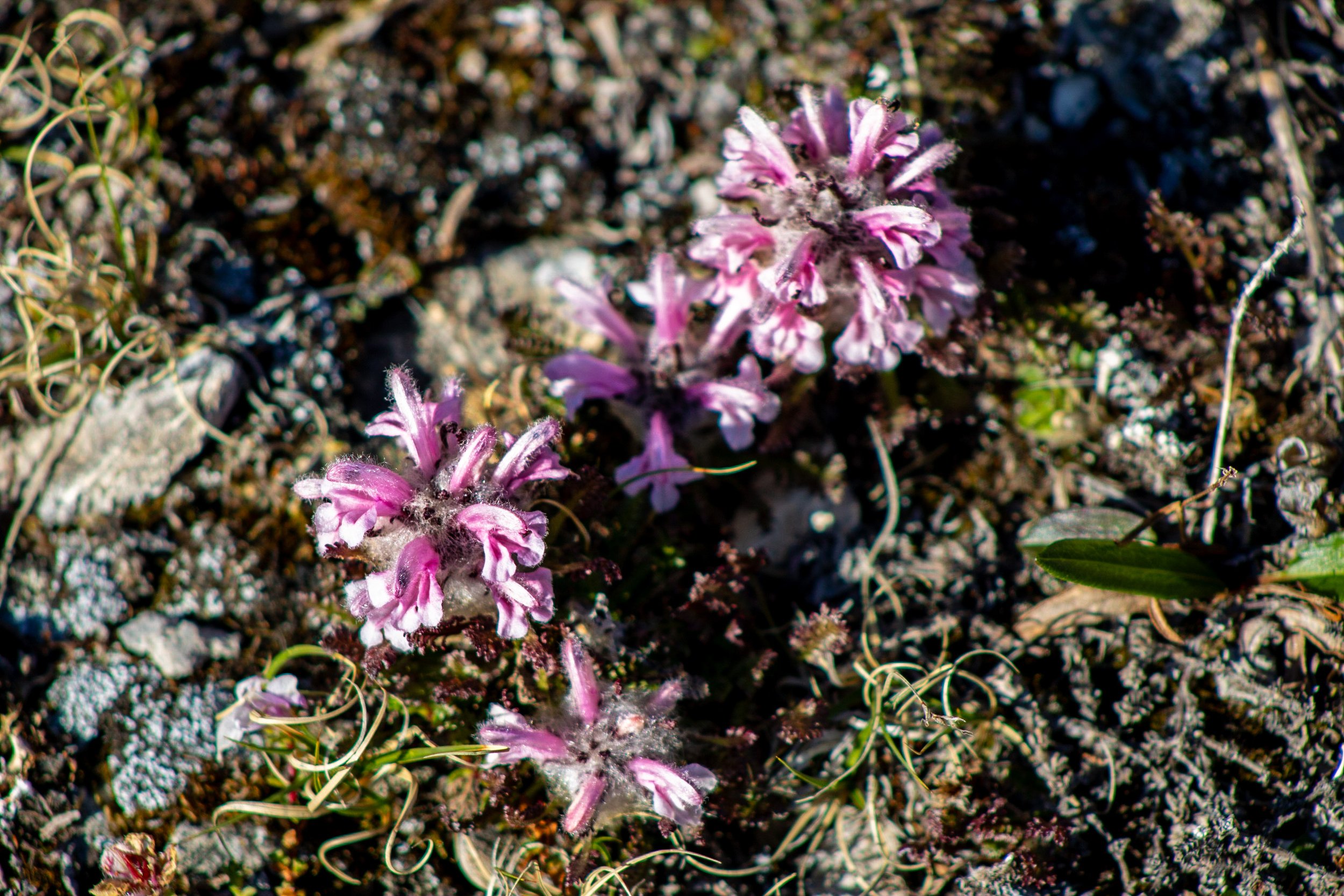
Surprisingly abundant plant life on Svalbard
But our trip also solidified new learnings as well. I now understand how crucial the polar regions are to the health of the entire planet’s ecosystem. The phytoplankton and zooplankton that thrive in these regions are integral to the food cycle that exists throughout the world’s oceans, and the prosperity of the oceans determines the life on land. This includes us; we are recipients of what occurs in the water in these parts of the world.

Bearded seal chilling on an iceberg
Polar bears only reside in the Arctic, and the opportunity to not only see them but spend prolonged bouts of time with them was a once-in-a-lifetime experience. They are amazing animals that contain full-fledged personalities. Their behavior is truly unpredictable, as we witnessed during each and every encounter. And they really are the regal symbols of the Arctic, and all that this special ecosystem represents.

Cody Bear tracking Junior
I know I will return to the polar regions some day. Their impact on my life cannot be overstated, and I feel reinvigorated about promoting the protection and appreciation of this planet. It is all connected, even these most unique and remote regions. We are connected to it. We are one planet, that will thrive or fall together. What’s our next move?

The unexpected side of Svalbard
I shouldn’t have been surprised. History dripped from every conversation; all the places we visited contained interesting facts about explorers and previous societies. Just like the Antarctic, hundreds of sailors ventured into the icy, ever changing waters of the Arctic.
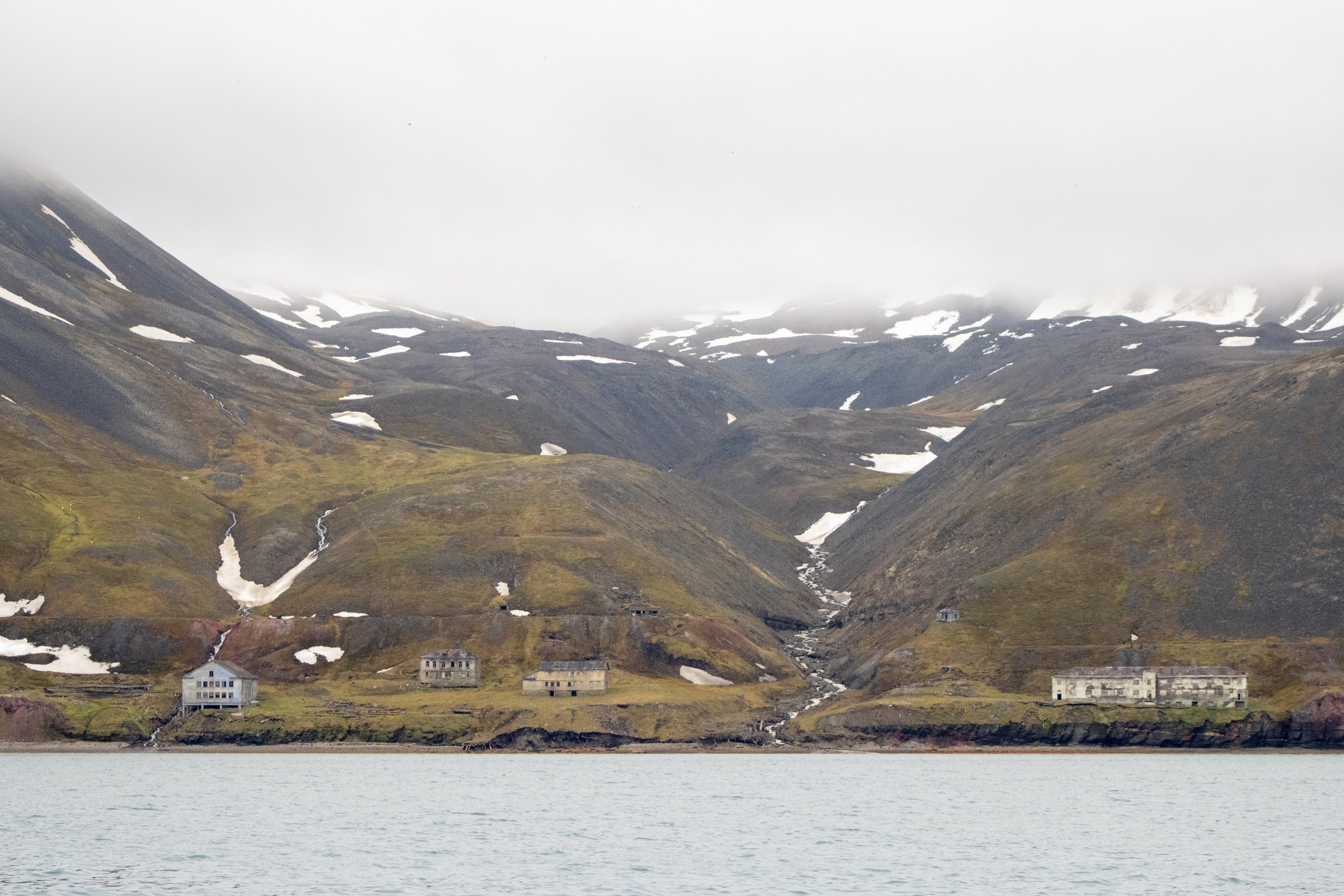
A settlement long deserted
Measly huts and sheds served as shelters to men for months, even during the winter. On our first landing of the trip, we visited a small two room cottage that stood for sixty years. A man, woman and three year old child lived there for over a year, and they even gave birth to a newborn. Stepping inside the hut, it was surreal to imagine raising a family in such a remote, inhospitable place—alone.
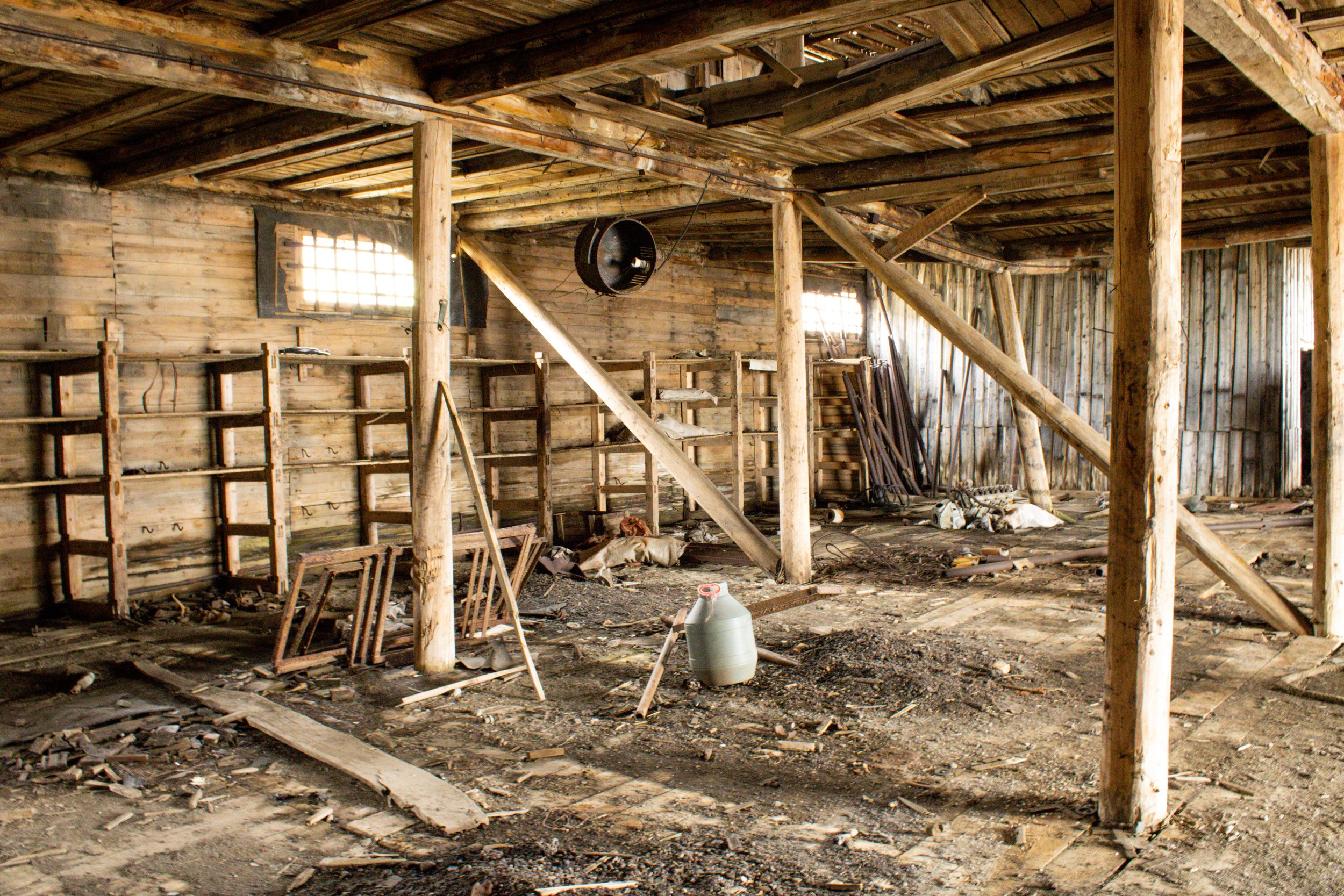
An abandoned building’s interior
We also visited a former coal mining town of the USSR. Abandoned and left as it originally stood, the smattering of buildings and infrastructure resembled a tiny ghost town. Storage crates and barrels of supplies remained unopened where they were. Even remains of the railroad tracks and the bridge/tunnel that transported the coal back to an airfield were still present. This limited infrastructure still hinted at a miserably cold winter experience.

New ship, old dock
The almost feeble attempts at settlement around the island of Spitsbergen were a reminder, almost a warning: we may possess the ability to create tools and manipulate our environment, but even on our own planet, we are at the mercy of the elements. We are fragile compared to the other animals that have adapted to thrive in this harsh environment. We may be mighty in many ways, but we are also small. This beautiful world is not our domain, but that of the universe. We are simply one part of it.
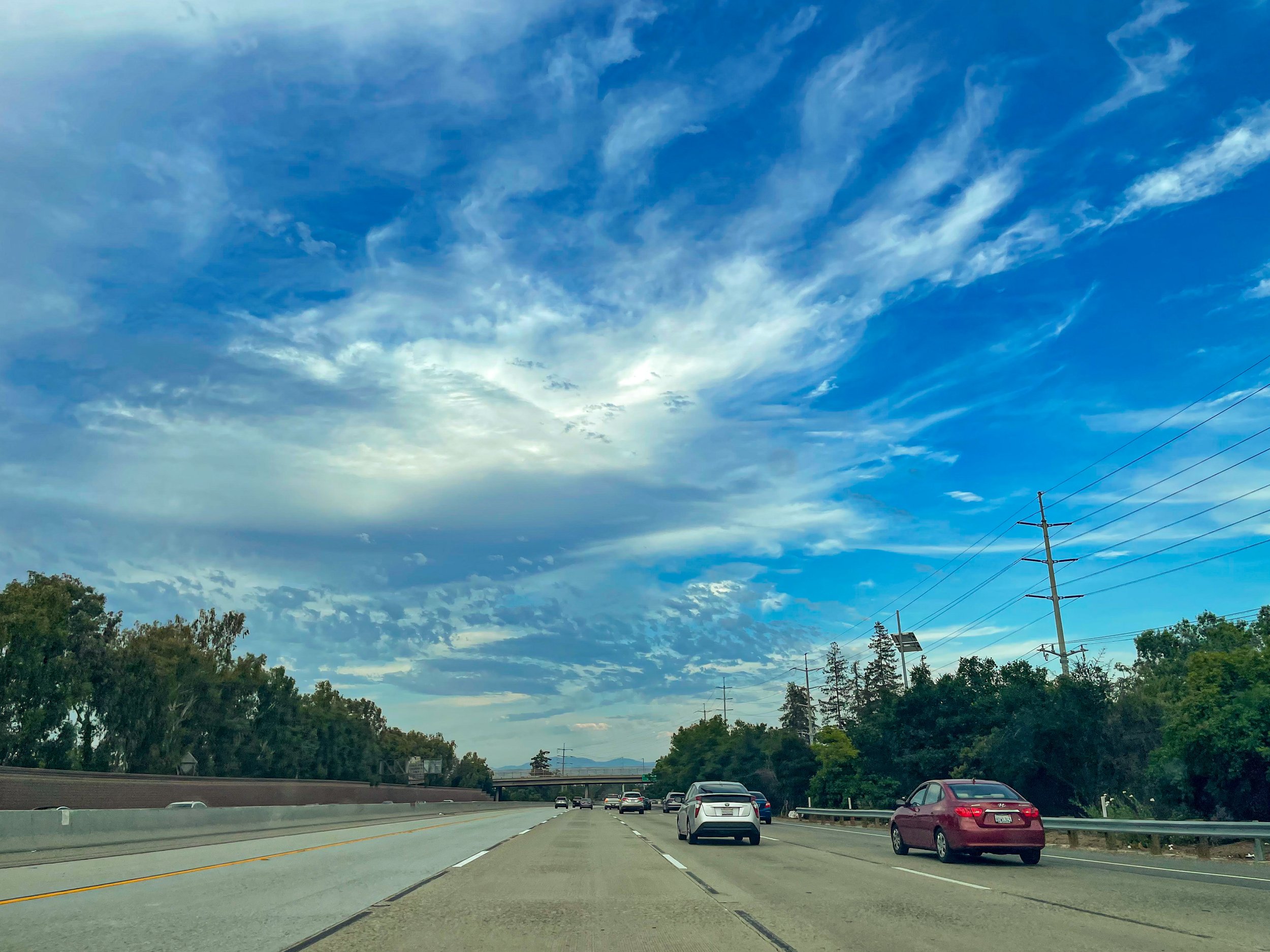
California today
The other day I thought about my top accomplishments. If someone asked you, “what are your biggest accomplishments thus far in life,” what would you say? I considered my answer:
I have succeeded in securing a mate, one of the primal purposes of mammalian species. My partner is the best, perfect partner for me. She is supportive and significantly increases my happiness, as well as my chances for “success” in life
I maintain a strong, close relationship with both my parents well into my thirties. That stat about children spending X% of their time with parents before age 18 is not true for me. My parents are two of the most important people in my life, and have enriched my experience. I go to them for advice and learn from their perspectives
These accomplishments might be atypical. Perhaps I can focus on the more “traditional” success measures. But I am proud of them nonetheless. What are yours?
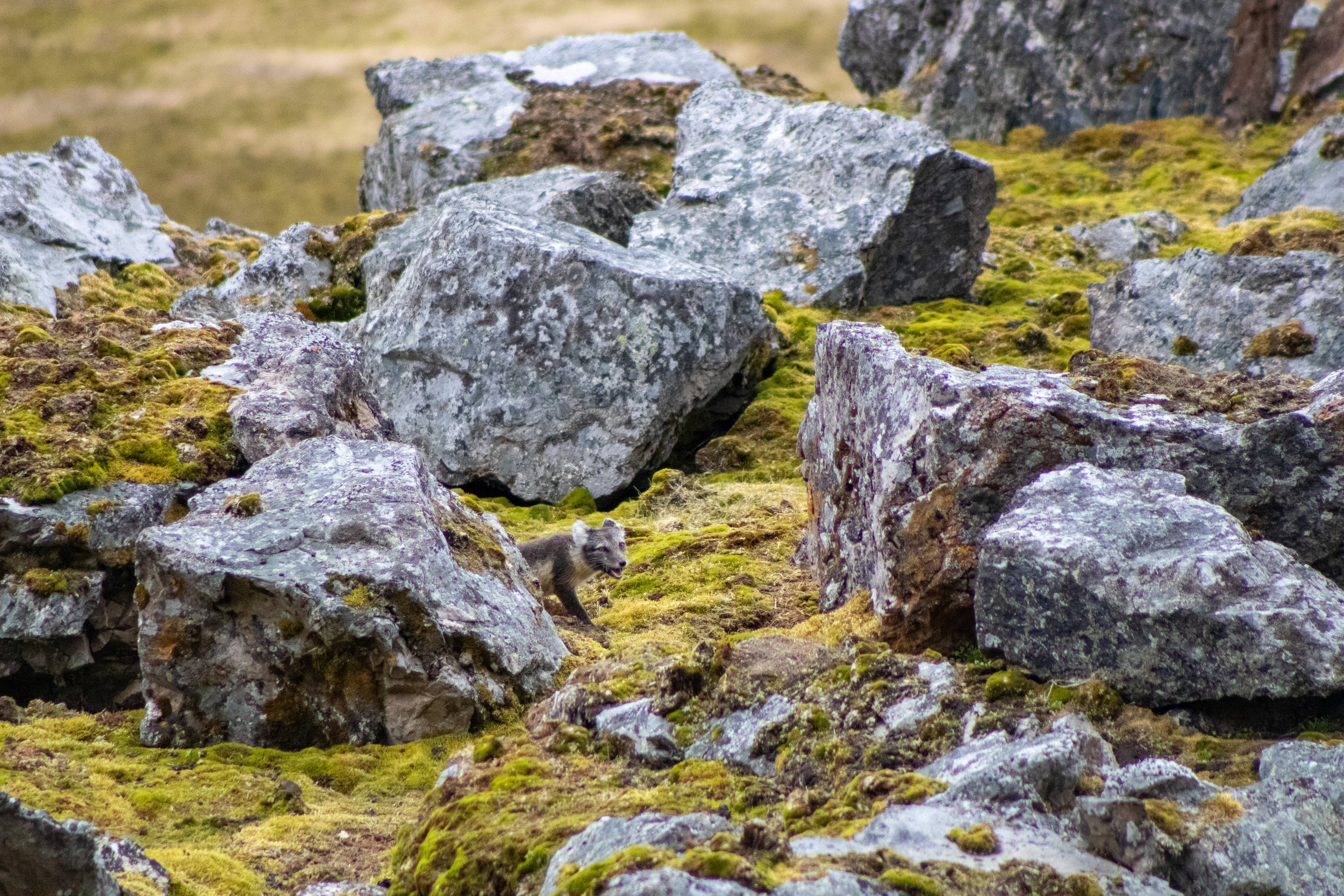
Chewing on some found food
We had been searching for an Arctic fox for days. Two of our fellow passengers, who had been to Svalbard many times before, particularly liked foxes, so we desperately looked for them as the days went on. On June 28th, the weather became calm and clear, which permitted us to land at Fuglehuken, the northernmost tip of the island of Prius Karls Forland. This narrow, elongated island is just west of the main western side of the island of Spitsbergen, and can only accommodate small ships. Our expedition leader had never landed here in all his travels to the archipelago, so we were very lucky.

Prancing reindeer crossing
A mountain rises at the tip of the island, and various bird species nest on the cliff face. These included gulls, little auks, puffins, and snow buntings. With the thousands of birds came thousands of nests—and with the nests, came foxes. Eager to see the elusive Arctic fox, we landed with anticipation and hiked up the hill to the base of the cliff. Passing reindeer along the way, we came to a good stoping point and stood to watch the birds. It was a cacophony of activity. Numerous different colors flashed across the sky as birds swooped to and from their nests on the vertical wall.
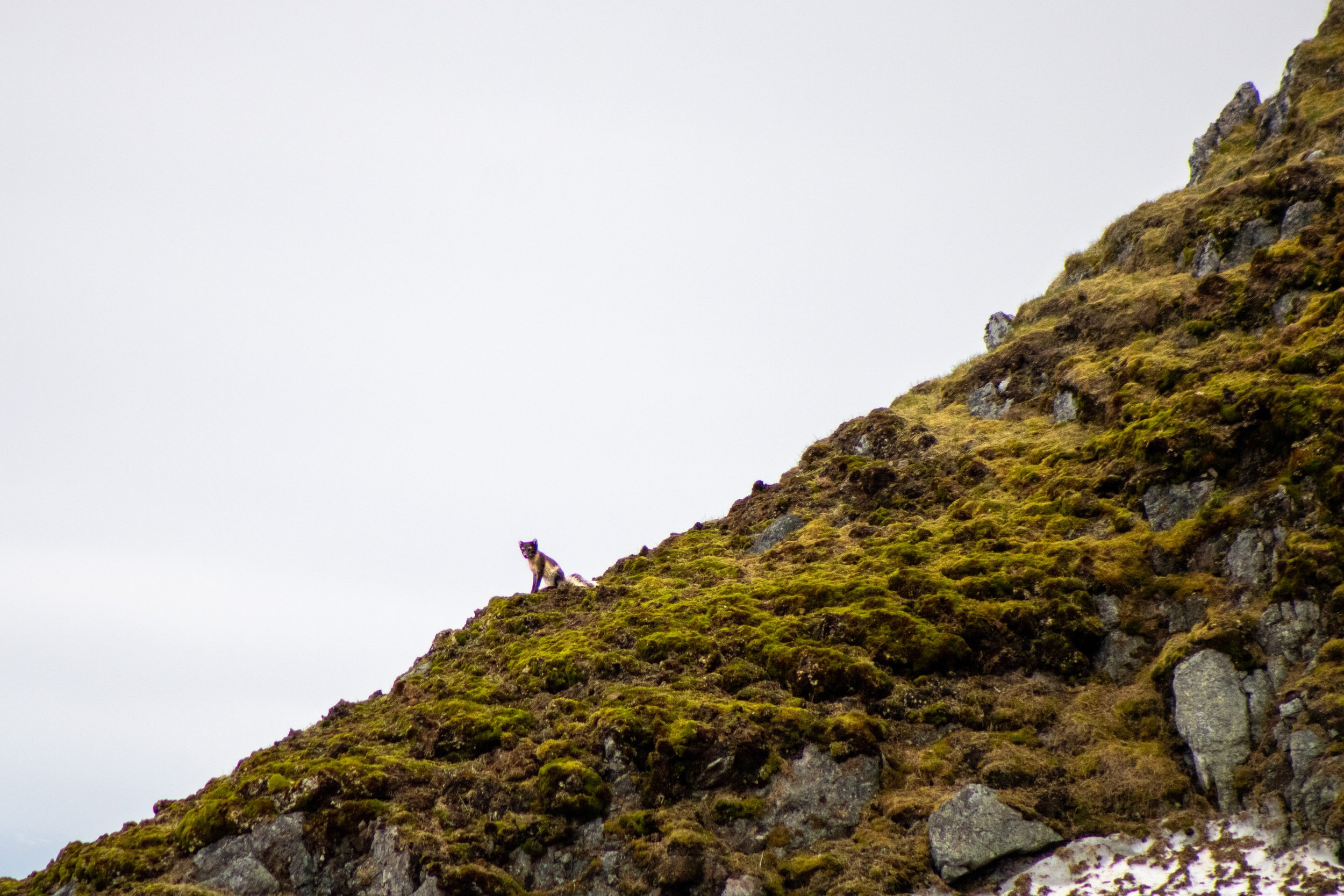
Our first fox enjoying the view
And then, my wife saw it—“Fox!” It was incredible how well it blended in with the green and brown environment. We could only see it because it was moving, darting between the rocks. Black, brown, white and gray, the size of a house cat, the fox kept checking back at us as it quickly climbed the hill. Eventually it reached a good vantage point, sitting and surveying the landscape for a while, before curling up and laying down for a nap. A charge of electric excitement surged through the group. The fox was so different from anything else we had seen thus far. I kept thinking about the phrase ‘clever as a fox,’ and how apt that comparison is. They definitely look intelligent, almost devious, and they move with purpose and cunning.

Dashing through the snow
After enjoying the birds and the fox on the hillside for some time, we started to turn to head back to the beach. But one of our guides yelled to go back to the front of the group. For a split second I thought he had seen a polar bear, and that there was danger. Instead, we turned to see another fox, a momma with five kits. They were so cute! Solid gray and tiny, they pounced on each other, suckled at their mother, and explored the landscape. Mom kept a watchful eye on us constantly, as the kits played on obliviously. It was magical to see foxes so young and so close.
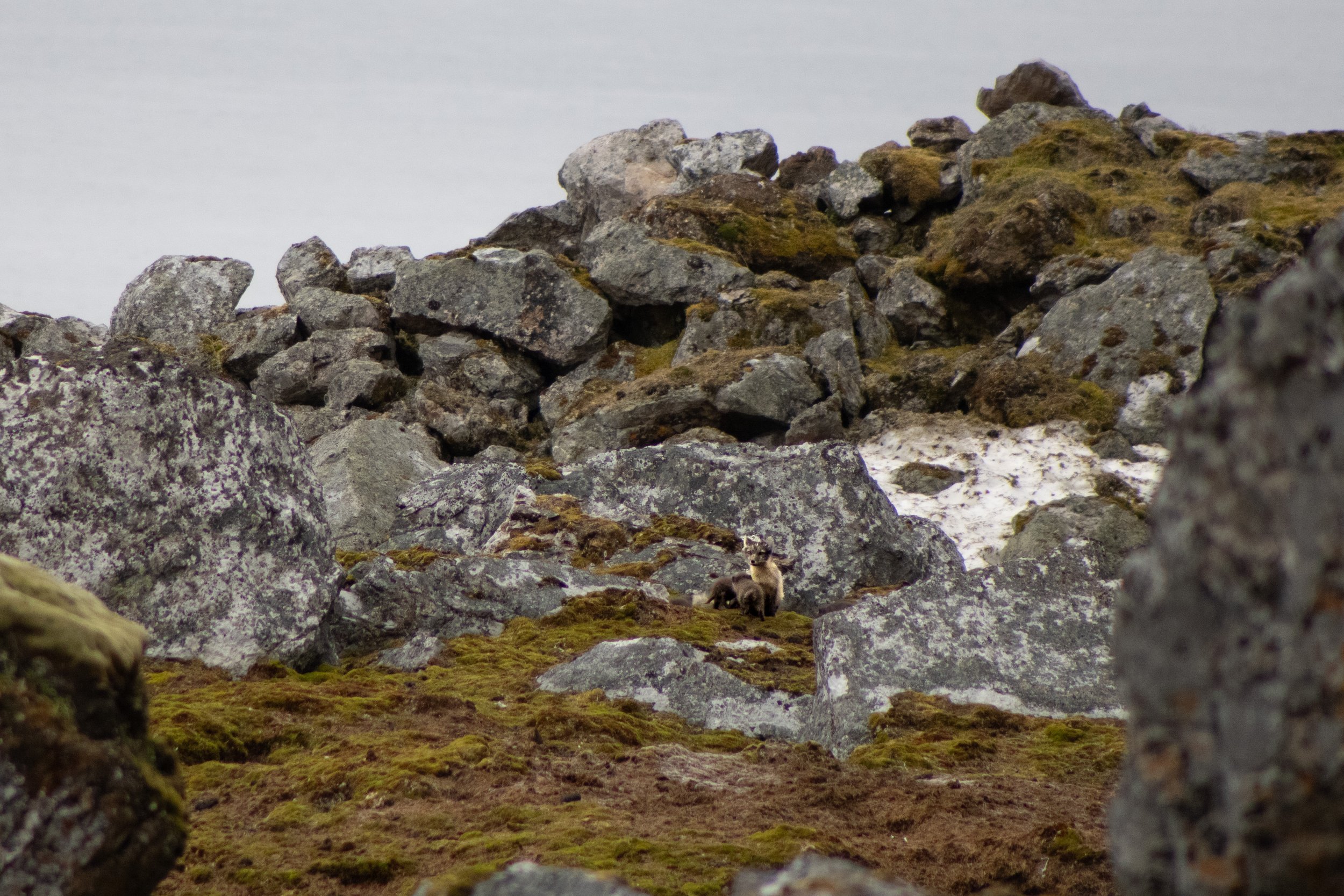
Fox family sighting
We thought we had seen it all as we finally started our return downhill to the landing site. But we saw another, and another fox. They ran along the low-lying hills. Our guides explained that although foxes are intensely territorial, the nesting site was a huge food source. The foxes were vocalizing to each other, likely proclaiming their territory boundaries. In all we saw twelve foxes, hardly believing what we were witnessing. It was evident how special Svalbard was. In an environment so inhospitable, there was all kinds of life everywhere. It felt like another world, but it was still Earth. It reinforced how unique our planet is. And we learned what the fox says.
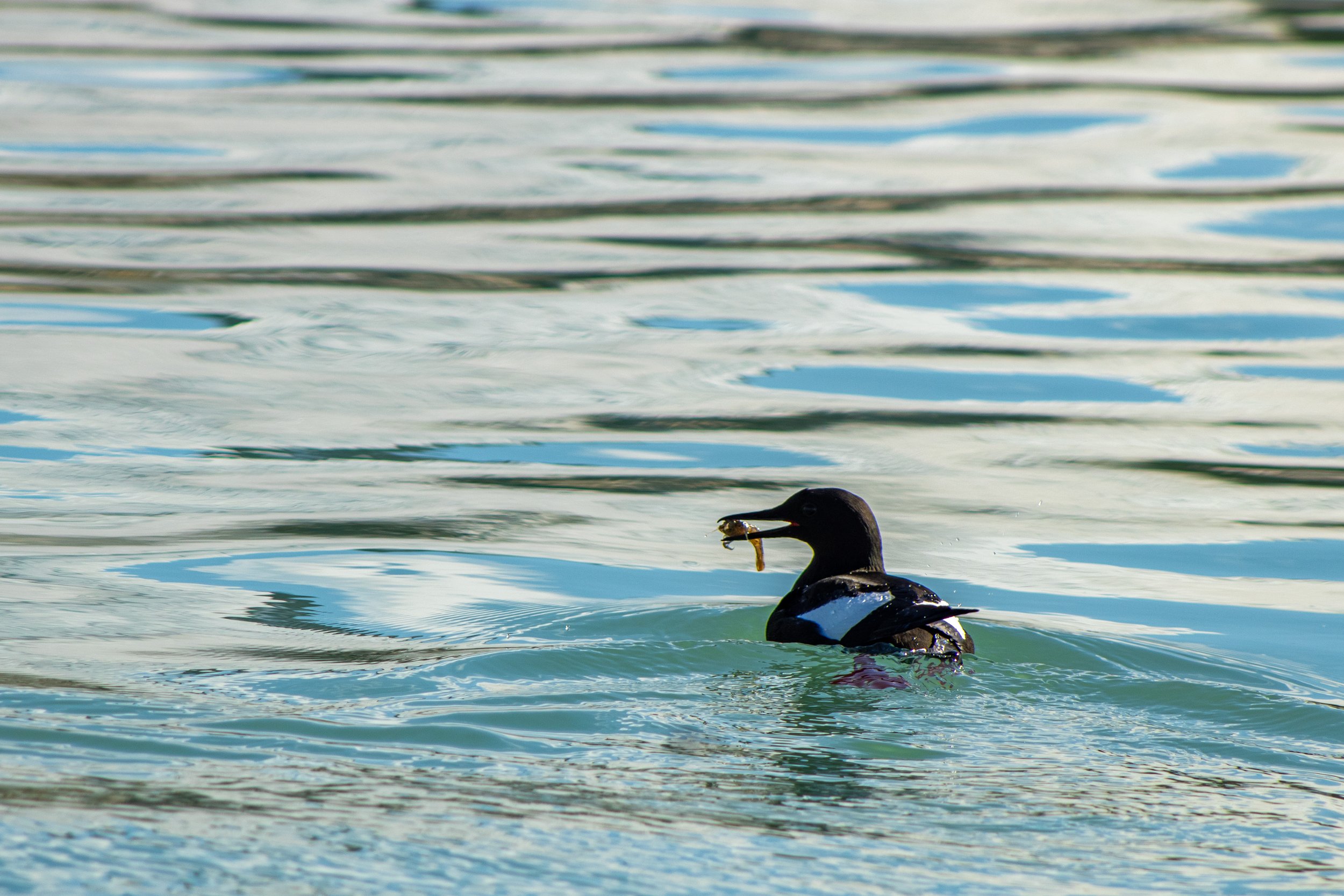
A guillemot munching on some krill
We first became intrigued with birds on our visit to Antarctica. It was whole new world; you’re introduced to so many different species in the polar regions. So we headed to the Arctic with excitement, not only for polar bears and whales, but for the birds.
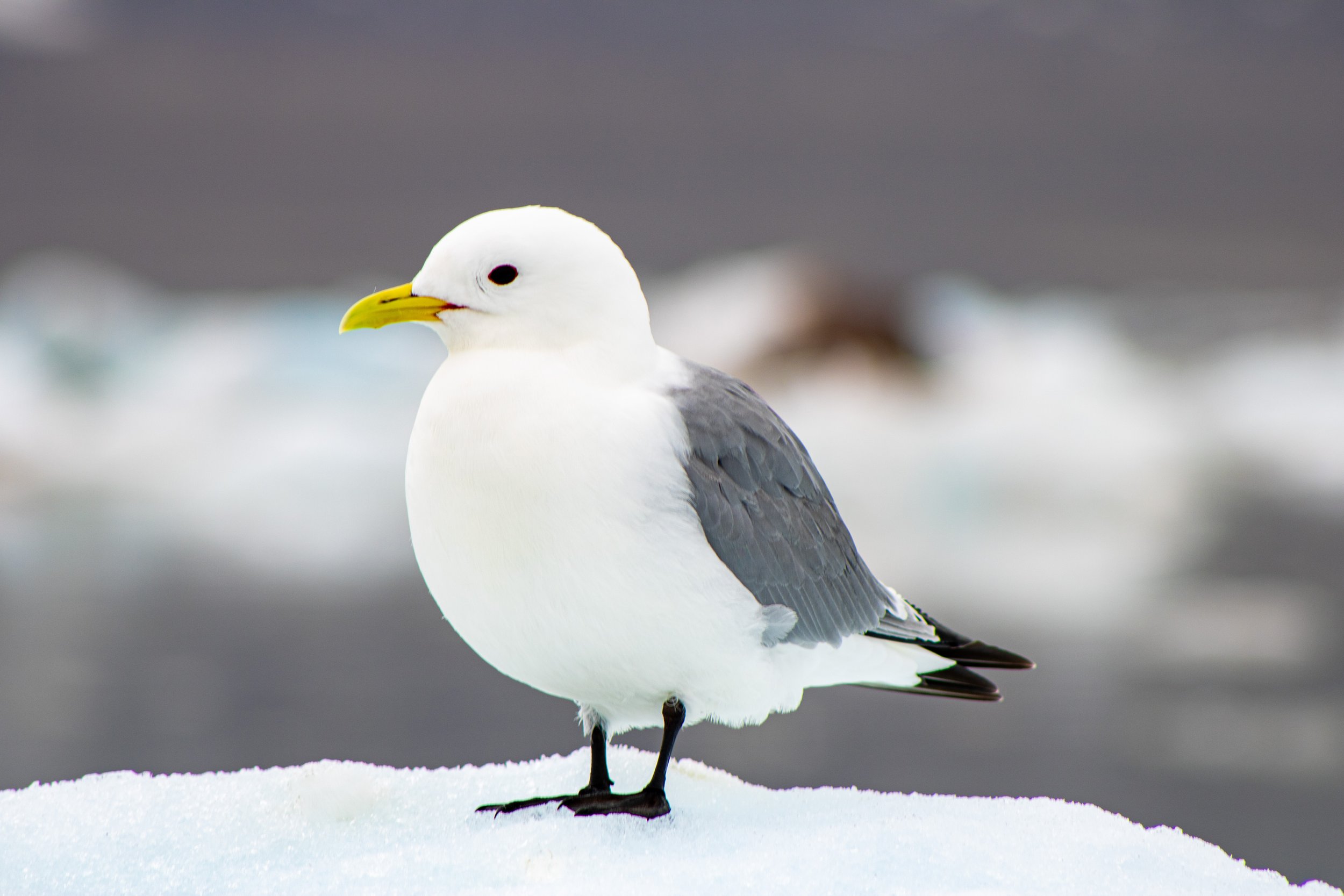
Kittiwake on an ice berg
There was so much to learn. I remember standing out on the deck on our first night departing from Longyearbyen, the photographer explaining a few different species to me. We saw Northern Fulmars and Puffins on that first night in abundance. It was my first time seeing a puffin since I visited Alaska as a kid. They were both so different than anything we saw down south.
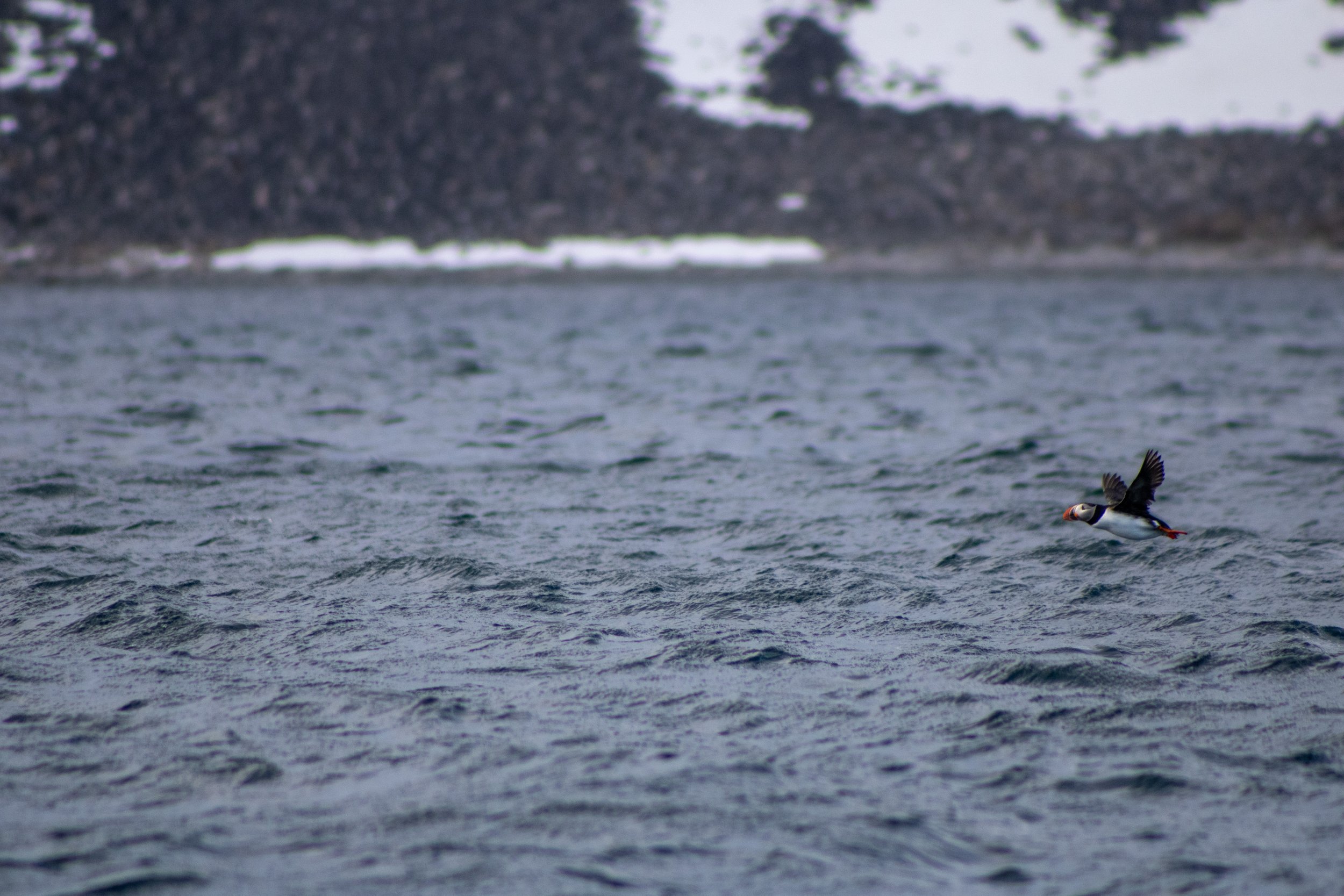
Puffin taking off from the water
The company that ran our trip is called Arctic Tern Expeditions. It was an apt name, as we saw dozens of Arctic Terns, if not more, while on our journey. We learned about these birds in the Antarctic, because we also saw them there: while the Antarctic Terns stay solely in Antarctica, the Arctic Terns migrate back and forth between the two poles. These amazing birds travel around 50,000 miles per year, roughly the equivalent of twice the Earth’s circumference. On our expedition we also learned these animals spend 95% of their lives in sunlight, as they spend time in each polar region during the “summer.”
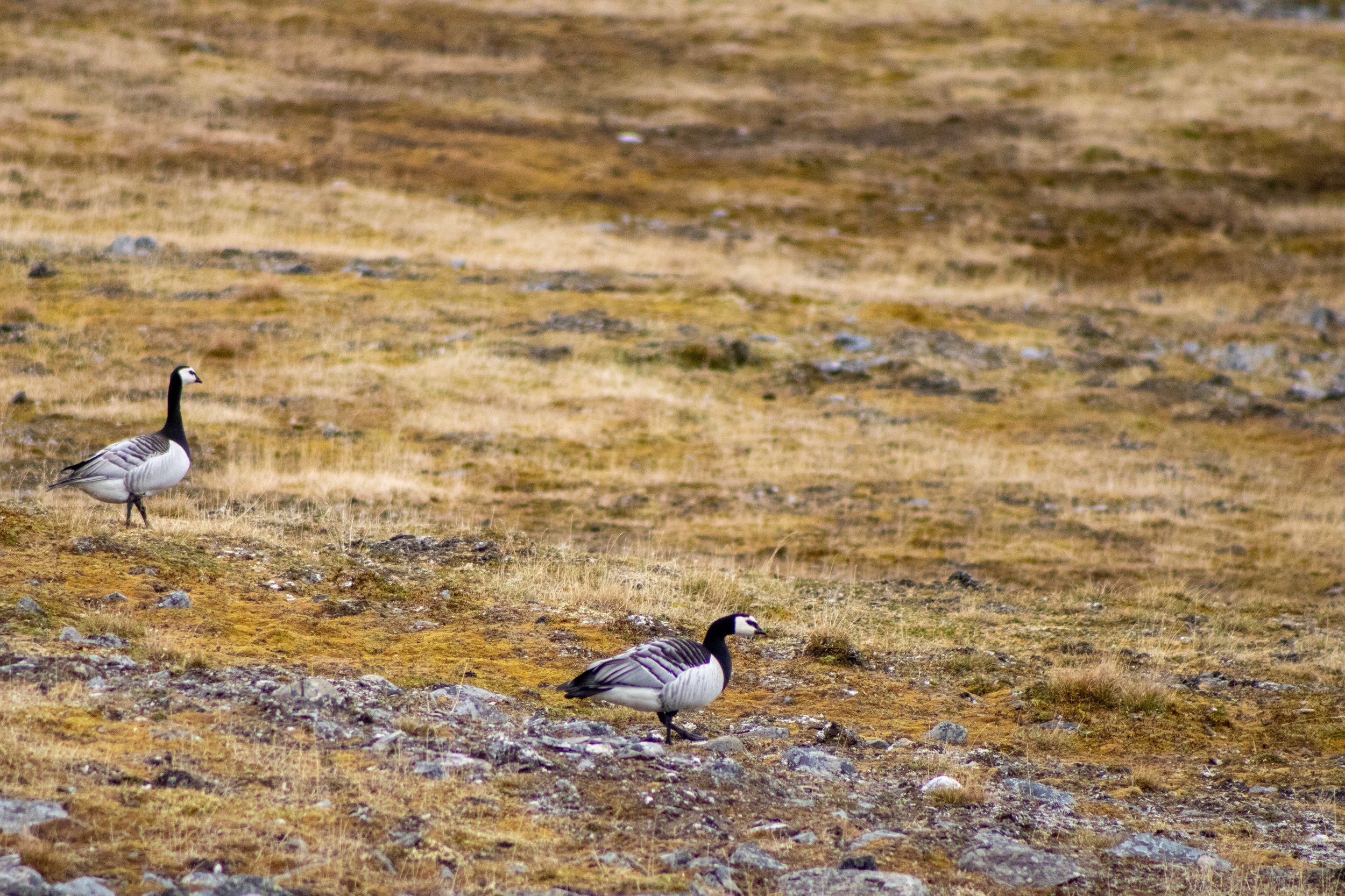
Barnacle geese looking for food
The Arctic is filled with incredible birds. As I already mentioned, the highly social kittiwakes hang out on icebergs near glaciers to wait for calvings, so they can swoop down on the shocked fish. Common Eiders filter for food on the sea floor using their beaks. The Little Auks build their nests on sheer cliff faces. And the Rock Ptarmigan, which we also saw along the side of a cliff while hiking, winters in Svalbard, despite the subzero temperatures. The birds were all around us all the time. And it was the bird nests that brought us the foxes.

Cody in animal cracker pose
After dinner that night we went up to the main deck as usual, looking for wildlife. It was a bright, peaceful evening with just a small breeze. As it always happens with whales, we suddenly spotted a blow and a fin way off in the distance behind us. A few fellow passengers and I scanned the horizon with our binoculars. There were at least 3-4 of them, and our guide identified them as a pod of orcas. We were excited, because orcas are difficult to see in the Arctic--they're only migratory. But our ship kept progressing forward, and it soon became clear why: our crew spotted a polar bear swimming in the water near the shore dead ahead.

Poking his head up to take a look at us
I wrenched myself from the rear deck and hurried toward the bow. There he was, our first bear up close, playing in the water with a sea log as if it were a pool noodle. We laughed gleefully as we watched him for nearly half an hour, grabbing the log with all four paws and using it to float in the water. He also partially climbed up a nearby rock and then launched himself backward back into the water. It was like he was performing a show for us, and yet you could tell he was simply happy, simply playing for his own amusement, playing because he could. Our expedition leader proclaimed him the most charismatic bear he had ever seen.
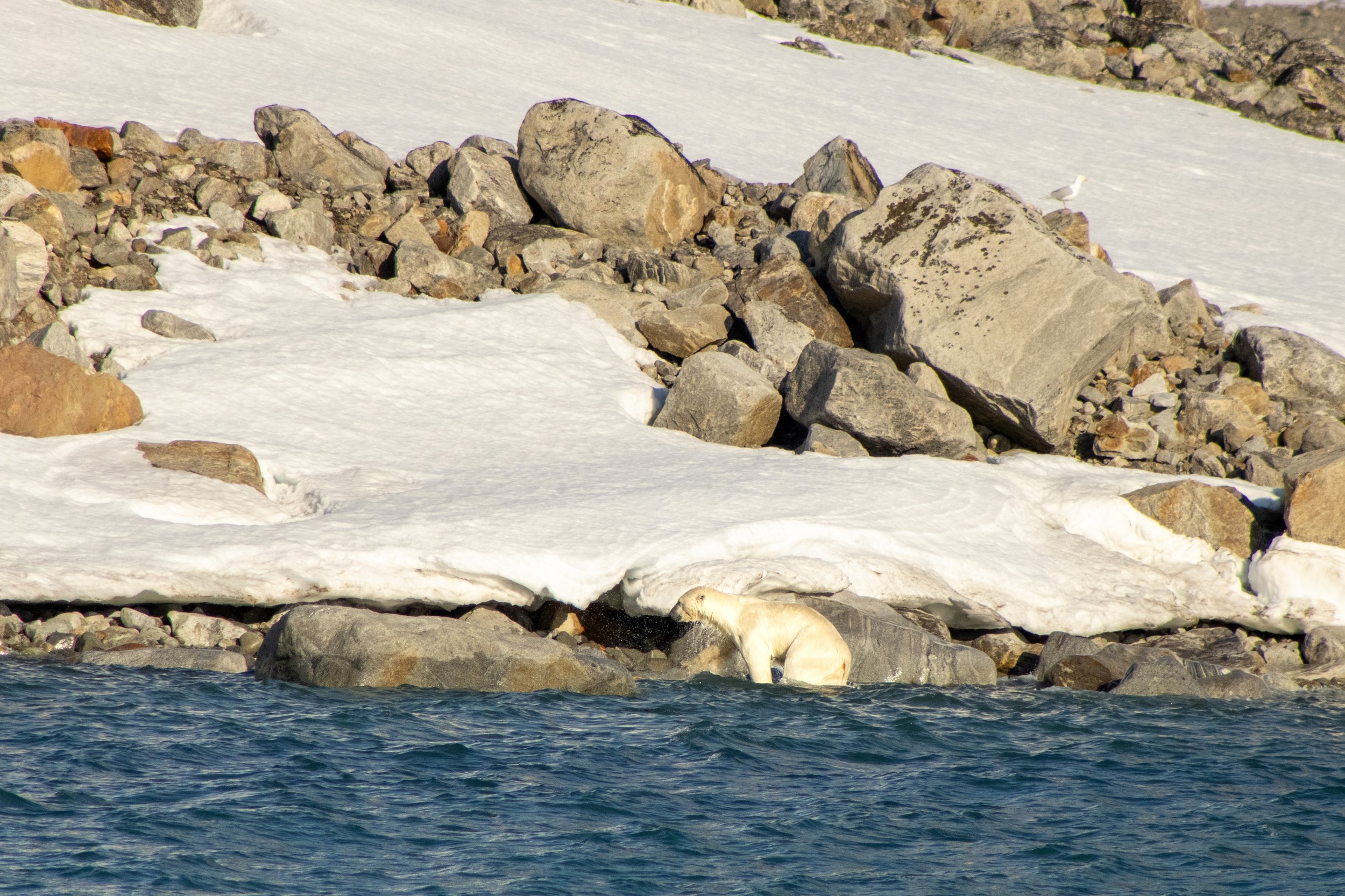
Cody getting out of the water for the first time
We watched him climb out of the water onto the shore, shake himself dry like a dog, then investigate various patches of snow. There was hole in the snow slightly up the slope, and we inferred he had probably created that. He flopped down in the hole and rolled onto his back, stretching his legs in all sorts of directions while grunting and snapping at the air. Again he was just having fun in the moment, for the sole purpose of enjoying life. It was at this point I named him Cody Bear, because he appeared this goofy, happy-go-lucky bear that enjoyed Svalbard to the fullest. We watched him lazily slide down the snow slope and then start walking to the left down the coast.

Being a derp in the snow
As we followed him down the shoreline, we saw another smaller boat approaching us. Our captain said they were following a bear too! We didn't believe them at first, thinking they were trying to swoop on our position (an unfortunately common occurrence in Svalbard). But then... we spotted a smaller bear, a male juvenile, walking in the opposite direction, toward Cody. What was going to happen?!? We waited with bated breath. As they got closer, the smaller bear picked up Cody's scent, and fearfully headed up the slope away from the shore, trying to avoid Cody. Being upwind, Cody carelessly plowed onward on his same track. We watched the smaller bear, who we named Junior, watch Cody and continue on toward the direction Cody came from, higher up on the hill. Cody seemed completely oblivious until he reached the spot where Junior diverged... then the chase was on.

Junior trying to escape
Cody turned around and began following Junior's scent. Junior realized he was being followed and picked up his pace, quickly outpacing Cody. Our guides explained that energy conservation is extremely important to polar bears, because they don't know when and where their next meal will come from. Cody's swimming, and this extended chase, was abnormal behavior. But Cody kept coming. Junior looked back and saw he was still being followed, so he got into the water and started swimming across a small bay to the next piece of land. It was incredible to watch him urgently swim, his head barely visible as we maintained our distance in the ship. There was no way Cody would follow, our guides said, because it was too much energy. Yet Cody did! We watched both bears swim toward the opposite shore, astounded.

Visual sighting
Junior reached the faraway bank and continued to walk away, slowing his pace a bit, assuming he had lost Cody. But Cody continued to make his way across the channel, and eventually turned up on the same bank. We started to become worried for Junior, because Cody was much bigger, and our guides stated this had now become a chase to the death. As Junior continued to slow down and become less perturbed, we urged him on silently. And then they both saw each other for the first time. Cody had caught up, and he saw Junior below him on the shoreline. Junior broke into a run, obviously terrified, and Cody pursued him in his same lumbering wake. We were all shocked and amped up as we watched Junior get into the water for a second time! Then Cody got there, and incredibly... followed after him! A second swim chase was on. We couldn't believe what we were witnessing.

Cody Bear pursuing Junior across the bay
It was at this point that we had to leave our two bears, because it's not allowed to follow bears in the water with a ship (for fear of disturbing them or altering their natural behavior). Before fully turning the ship around though, we lost Junior. We could still see Cody swimming in his straight line after his original direction, but couldn't find Junior. Then we spotted him crossing the larger channel, in a perpendicular direction--a long swim! We deduced he was circling around Cody and attempting to double back. Cody reached the opposite shore completely unaware, and as we turned away, we assumed Junior had successfully evaded the confrontation. Three and a half hours had passed, and it was all of a sudden past midnight. We staggered to bed, trying to sleep, processing all we had seen. We witnessed the majesty of polar bears, and their unpredictable nature. It was hard to believe we shared this Earth with such magnificent creatures. How lucky we are.

Our ship, the Cape Race
We awoke on the 26th of June to a swath of fog covering the area around our ship. Our captain and expedition guides always warned the weather can change quickly, and it finally did for us. Our original plan to fully explore the northern coast of Spitsbergen and the boundary of sea ice foiled, we instead set our sights on another destination: 80 degrees north. I didn't know this was something sought after until hearing from some of the other passengers and crew. Longyearbyen, the main settlement in Svalbard, is already at 78 degrees north, holding the record for northernmost commercial airport, northernmost gourmet restaurant, northernmost bar... you get the idea. Apparently even fewer people cross into the 80's.

The moment we reached 80 degrees north on the bridge
It was surreal traveling through fog in all directions to the horizon. It was like we were traveling through a wormhole, to a completely different world. We all gathered in the bridge to witness the threshold crossing, and one of our passengers got to blow the horn. Just like landing on the continent of Antarctica, this was an “accomplishment” I knew nothing about. But few souls have ventured so far north.
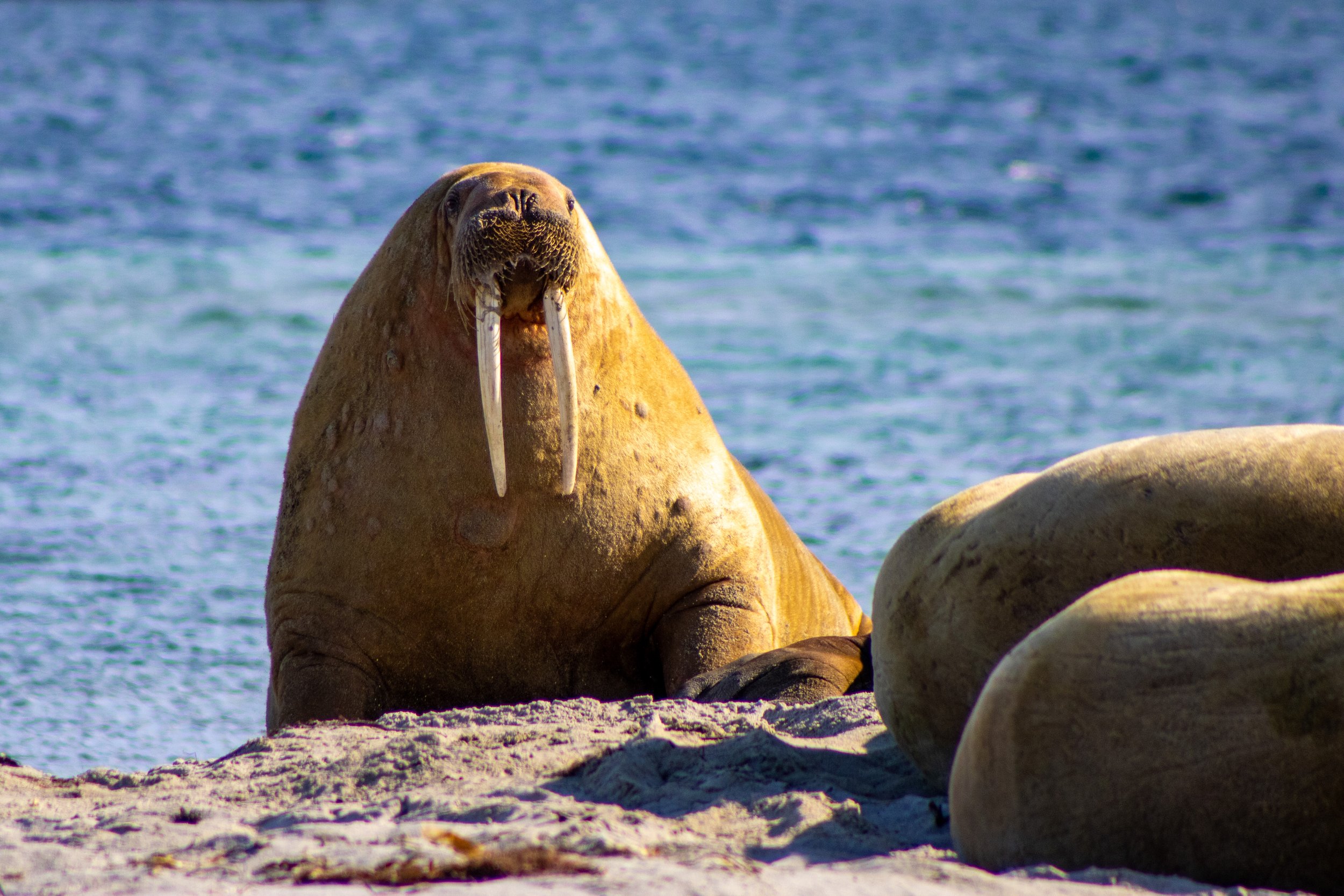
Long-tusked walrus on the beach
And then it was back down to walruses. We headed south towards where we came, toward Longyearbyen. Our destination was a landing site we were previously bumped from by a larger ship on our first full day: a common location for herds of walruses to show up. After anchoring, we took the zodiacs to a small spit of land where about forty were gathered, resting on each other on the beach. The smell was horrid. And the animals were huge, some of the adult males reaching 3,500 pounds. While they mostly lay and rolled over, some sparred with each other when one touched another in a place they didn’t like. We observed them for almost an hour, watching these huge creatures along the beach. We had seen juvenile elephant seals in South Georgia, which were roughly the same size, but there were only a few of those then. To see the sheer weight and size of all these animals up close was exhilarating.

The harbor seals camouflage very well
Finally, we moved to another spot to do our last excursion of the day. It was one more zodiac cruise in a shallow, sheltered bay, where we came across several harbor seals, some with their pups. Much more timid and nervous than the bearded seals, they anxiously watched us as they swam around the small cove. The babies were adorable; it was watching a new cycle of life begin in Svalbard. We thought it a fantastic end to an eventful day. And how wrong we were.

Our first walrus amongst a beautiful backdrop
I knew our wedding anniversary would be different this year—it would be the first one without a wedding ceremony. But I had no idea it would be so special in this way. On June 25th, we were awoken by our expedition leader informing us they had spotted not one, but two polar bears: a mom and her cub. We frantically got dress and up on deck, watching them move across a low plain beneath a mountain. It was surreal to see a polar bear in the wild for the first time. They were an off-white, clearly visible in the surrounding snow, and were walking along like they didn’t have a care in the world. The crew loaded both zodiacs and we prepared for a cruise. Unfortunately, that was the end of our time with them. Mom and cub both disappeared over a ridge, and while we searched for them for well over an hour in the zodiacs, we couldn’t find them again. Our consolidation was approaching incredibly close to yet another glacier, and spending time with another bearded seal.
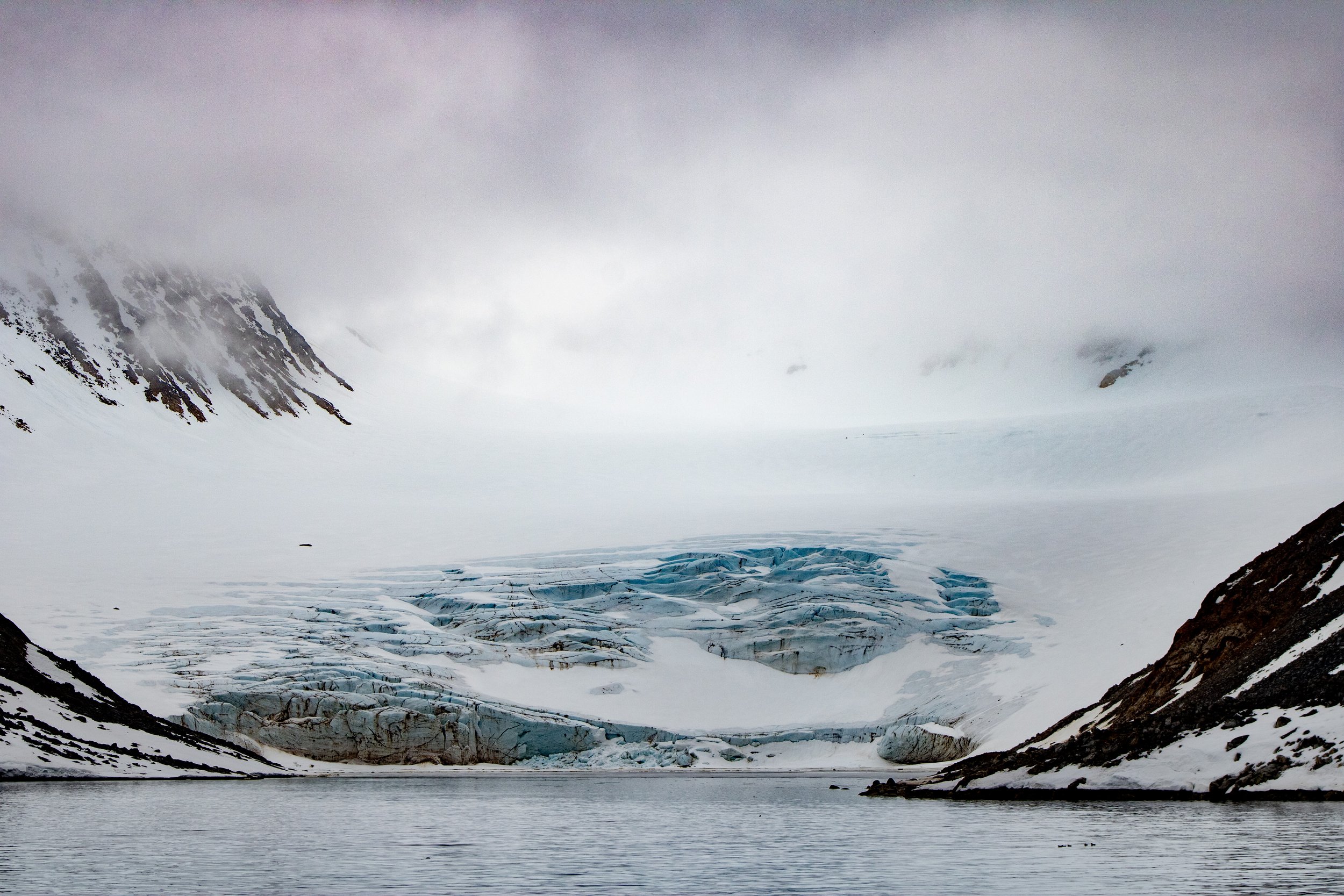
The immense glacier shrouded in fog and snow
We still got to do two landings that day. On the first one, we pulled into a beautiful glacial bay surrounded by snowcapped mountains. The boarding routine starting to become familiar, we changed into our protective clothing, pulled on our rubber boots, fastened on our lifejackets, and took the ladders down to our zodiacs to head to shore. It was covered in lichen, which seemed incredible. How could so many different species of plants survive further than 78 degrees North? We also came across some polar bear paw prints in the snow, and exciting but also spooky sign. It felt like we could run into one at any moment. Although we felt safe with our guides (and their big game rifles), it was also clear that we were visiting a truly wild place, in which we were not the top animal.

Zodiacs and the Cape Race
The second landing in the afternoon was even more spectacular than the first. We journeyed up to the northwestern corner of Spitsbergen island, and anchored in between a few of the smaller islands off the coast. Our guides then took us on a guided hike up one of the islands, in which we had a magnificent view of the channel and the surrounding scenery. We trudged through the soggy tundra at the base, carefully avoiding the nesting Arctic Terns, which are very territorial. Then it was up, up toward the peak, probably 500 feet up. The view was inspiring. It was as if all the northern world lay out before us in splendor. I felt moved by the beauty of the Earth and the wonder at being in such a special place with my life partner.
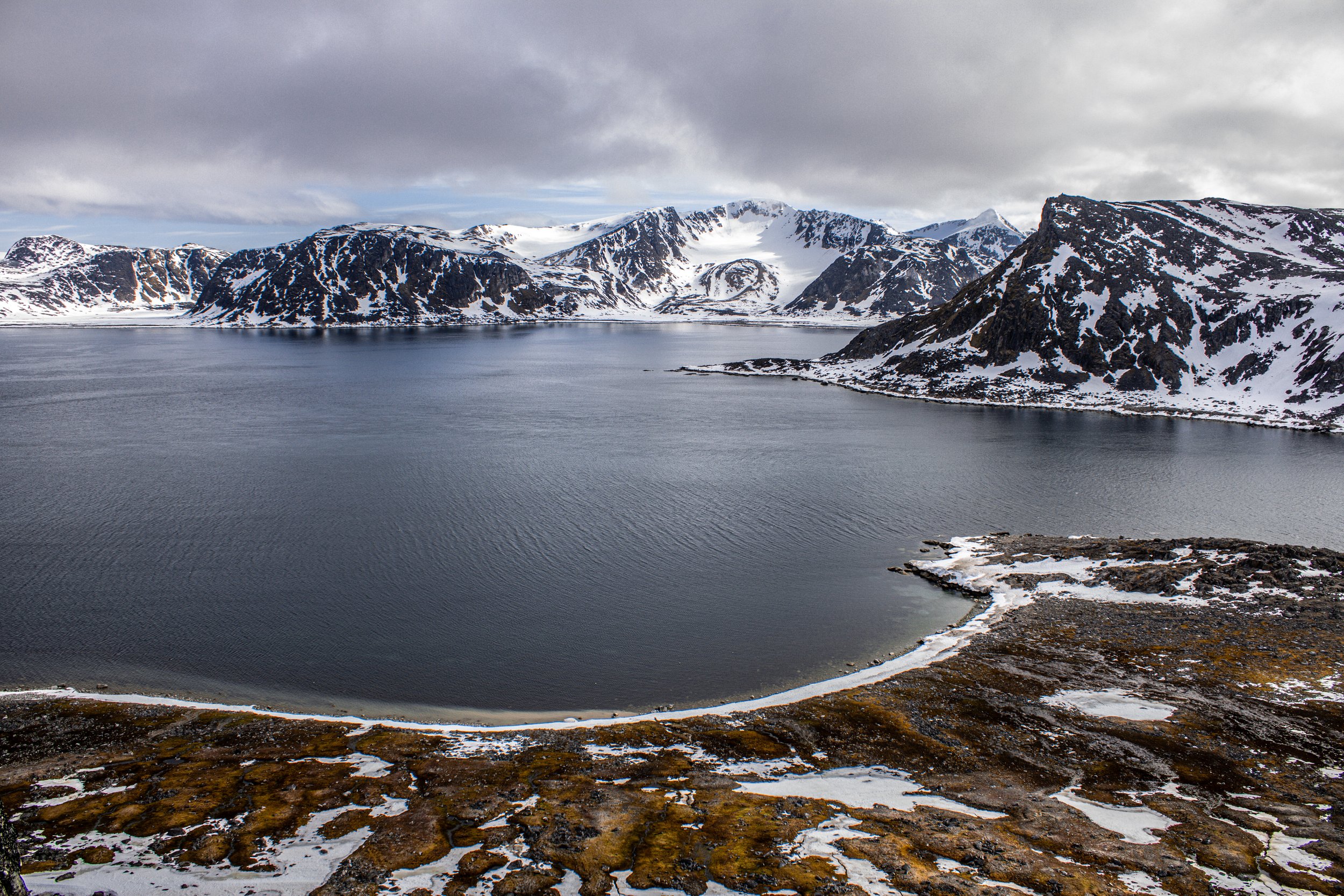
The view from our hike
I assumed that would be the highlight of our day as we returned to the ship, which then headed northeast around the corner of Svalbard’s biggest island. How wrong I was. After dinner, the sun still blaring outside, we headed up on deck to watch our approach into a beautiful bay. All was silent, as the water turned to glass. Then we spotted a lone walrus resting on an iceberg up ahead. We barely slowed down to admire it, even though it was our first sighting of the species, because our crew spotted a pod of beluga whales. There were at least 30 of them, which our guide Marcelo called “sea bananas”—you mostly only saw their yellowish humped backs as they surfaced to get new air. We followed them deeper into the bay, until the ice pack, then anchored. We watched them for hours, until we had to split our viewing time: one of our fellow passengers unbelievably spotted another polar bear, moving back and forth across the ice roughly two miles away from our ship. The entire ship, passengers and crew alike, watched both sightings with giddy joy—it was hard to know which animals to watch!
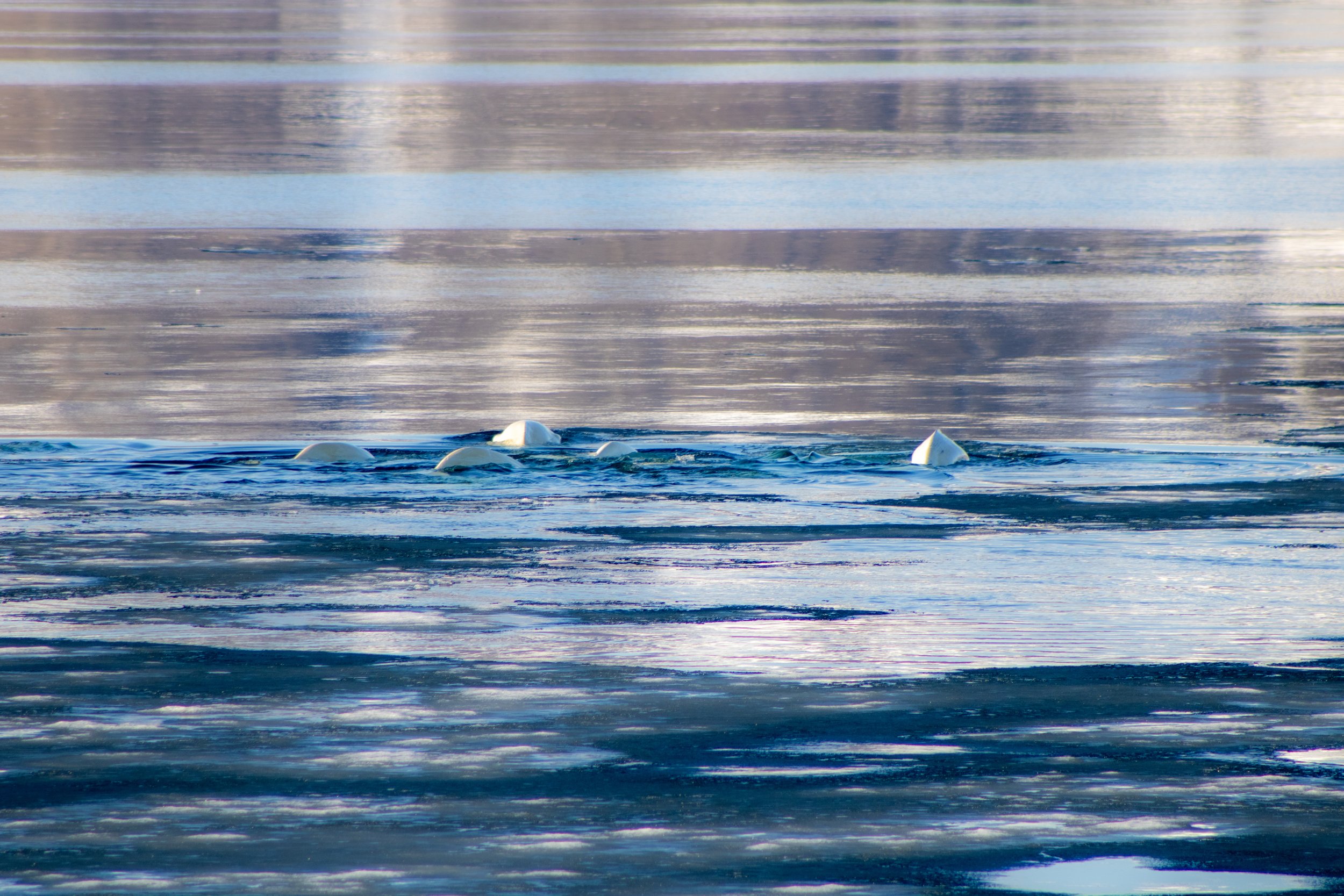
Watching belugas from our ship at midnight
As the “day” drew to a close, my wife and I took a picture on the top deck with the midnight sun. There was minimal change in the sun’s height in the sky as the clock turned toward a new day. It was the most beautiful anniversary day we could ask for, with three polar bear sightings, incredible scenery, and walrus and beluga watching. I’ll remember it for the rest of my life. And maybe, because it was a special day for me personally, the magic of the Arctic will also imprint on my brain. I knew as I lay my head down to rest that night: we inhabit the most spectacular planet imaginable.

Scenery from our first zodiac cruise
This post was written on the 1st full day of our Svalbard Expedition…
Today was even better than the first day. Partially due to jet lag, and partially due to the amazing unique things we are seeing and doing, it’s hard to know which day is which. The Arctic is teeming with life. When you look outside our boat, in any direction, you’ll see some type of life—usually birds. But we also saw several reindeer today, both near and far, and two separate pods of minke whales, and we had amazing close encounters with seals.

Looking back toward the ship and our group
I felt some apprehension during our first landing in the morning. It would be our first time going ashore on Svalbard outside of Longyearbyen, and there are polar bears wandering around… Martin, our captain, and Heidi and Freddy, our first and second mates, dropped the zodiacs into the water after breakfast. After Phil and Marcelo, our two guides, checked the coast for any sign of polar bears, we boarded and headed to shore. It was great to walk around. There was no sign of any polar bears… except for the damage to one of the historical huts and the paw prints on the door. Apparently a polar bear had been “playing” with the wooden wall of one of the huts. It was slightly ominous. We also got to see a mating pair of long-tailed ducks as well as a pectoral sandpiper. It was our first close encounter with the Svalbard wildlife.
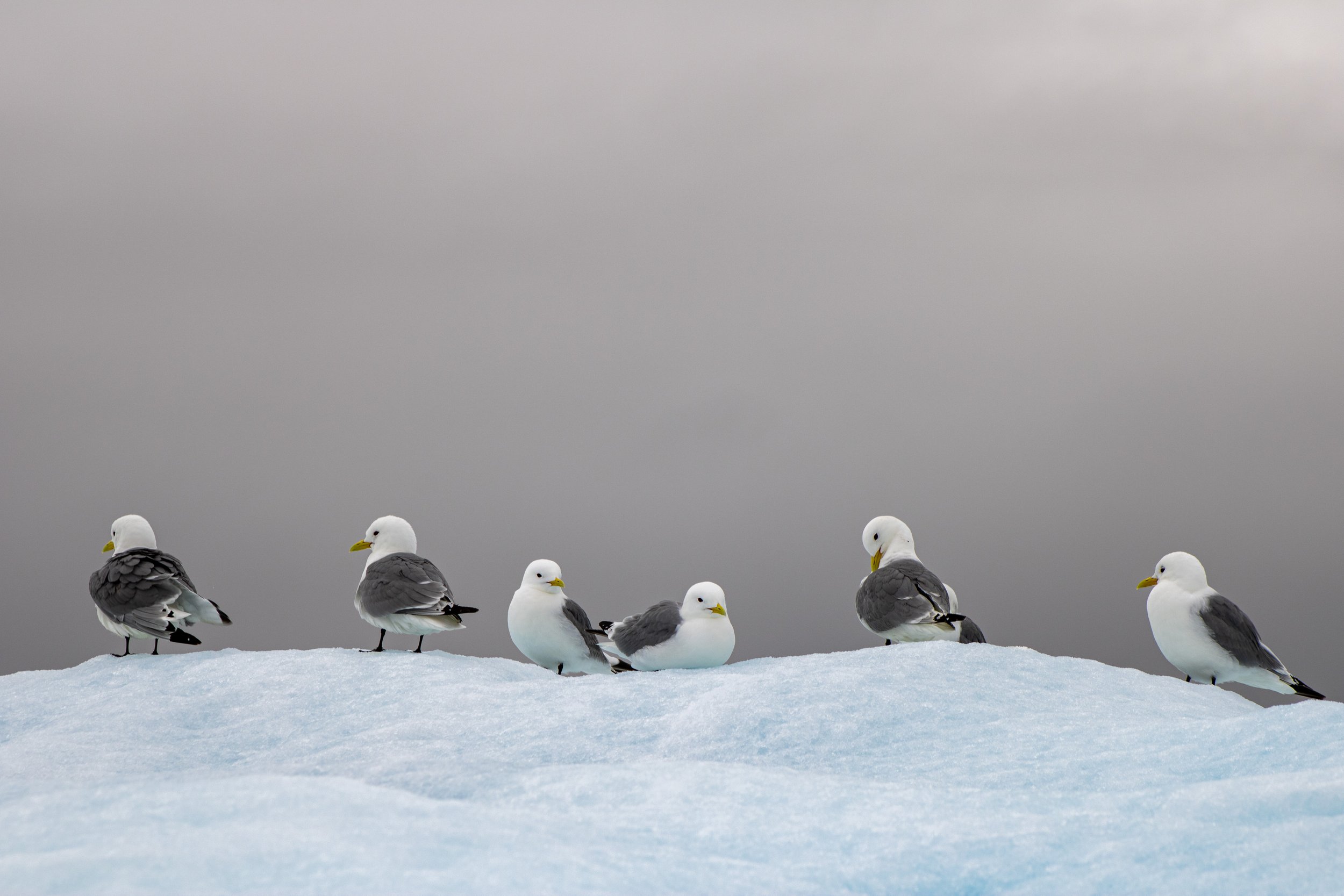
The very social kittiwakes
But the highlight definitely came in the afternoon. We moved to a smaller glacial bay in the afternoon and dropped anchor. With a magnificent glacier as a backdrop, the water was completely littered with ice floes. We got in our zodiacs for a cruise and were transported to a different world. Drifting slowly through the ice, no one saying a word, all we could hear were the sounds of popping and clicking. Our guides deftly guided the zodiacs around the larger icebergs, and we even touched some of the smaller bergy bits and growlers. It was peaceful, and yet utterly active. We passed a social group of black-legged kittiwakes perched on a glacier. These birds wait for the glacier to calve and then pounce on the shocked fish below. We witnessed the enormous glacier behind us calve multiple times, in complete awe.

Surrounded by blue ice
And then we spotted the bearded seals. Slowly, silently, we glided towards them, one by one. They each were resting atop shallow domed icebergs, resting in the cool air. Twenty yards, ten yards, fifteen feet… we kept inching closer. Our guides were shocked the seals weren’t spooked by our presence; normally they leap off the iceberg back into the sea at any sign of danger. Curious, they regarded us warily from their ice perch as we gaped in stunned silence. It was incredible to spend nearly any hour so close to these creatures. It was the epitome of up close and personal.

Up close and personal with a bearded seal
It was our first time seeing bearded seals, or kittiwakes, or drifting through the ice like that. No one wanted to return to the ship. For the second day in a row, we experienced a different realm. The Arctic’s wildlife and environment captivated and captured us. It was plain to understand: we are a part of this magnificent Earth, one component of a magical planetary phenomenon. We are not the masters of it, but participants. It’s all so clear, if one can simply take in the myriad of sights and sounds.
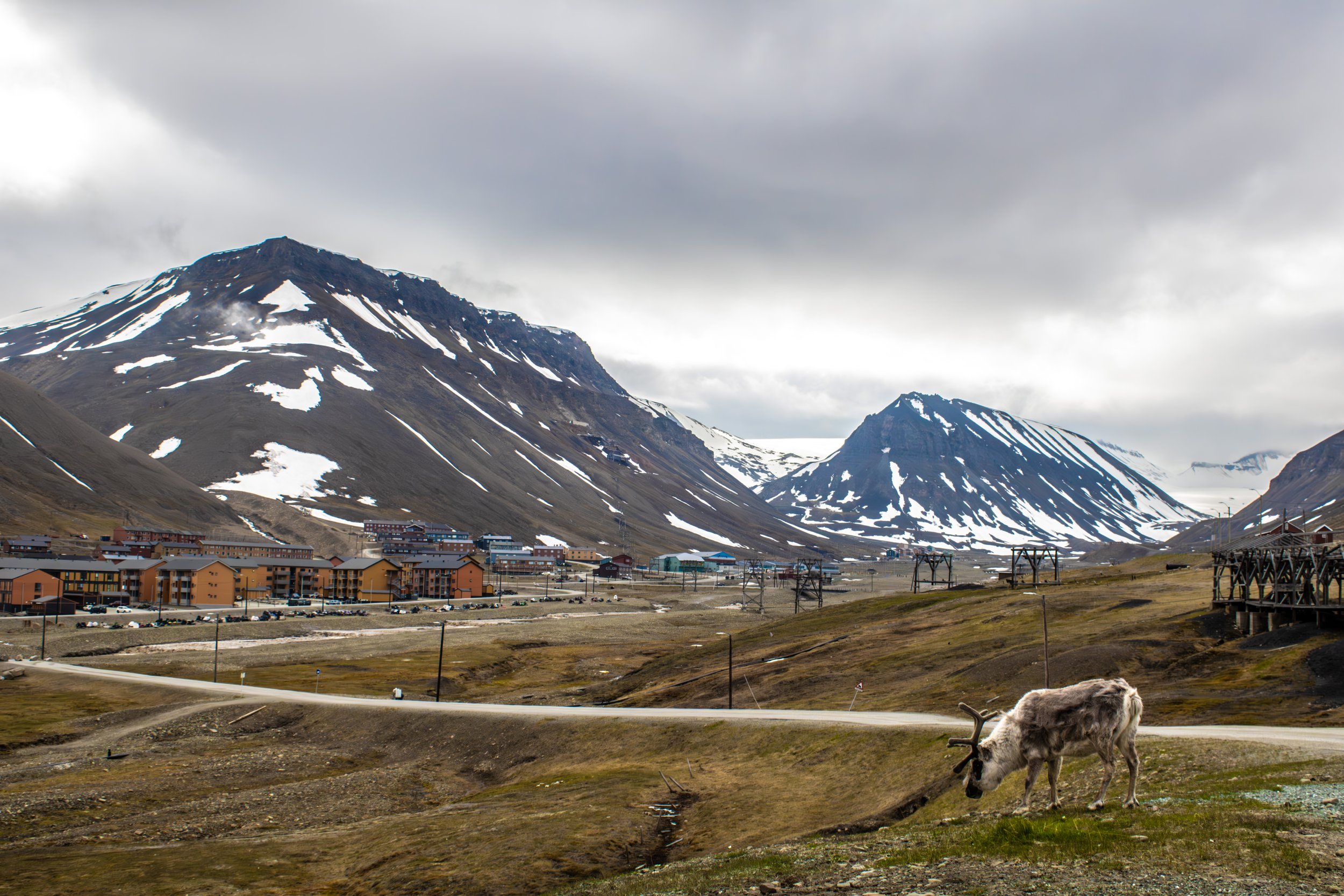
Watching a reindeer outside Longyearbyen, Svalbard
We’re off! On Friday, June 23rd we boarded the M/S Cape Race and embarked on what would become a 9 day journey. Describing our emotions as excitement is an understatement. We awoke at the Radisson Polar Blu hotel in Longyearbyenwith anticipation. After a leisurely breakfast looking out the huge windows to the mountains north of town, we packed up, checked out, and wandered outside for a walk. It was nice to explore the town a bit more, without as much jet lag. Longyearbyen is an intriguing place: remote, utilitarian, and simple. A town of about 1,000 people located at 78 degrees North, there are only a few streets and various establishments for services. It definitely feels like the northernmost city in the world.

The town of Longyearbyen
We headed to see the ship for the first time at 4pm. After some safety briefings and explanations about what to expect for the next week, we set off. I clicked away as we drifted toward the unknown. It was fascinating to experience the Arctic after having already visited the Antarctic. The polar regions are certainly similar. You feel the same remoteness in Svalbard as you do down south; you somehow know you’re at the end of the Earth. The midnight sun embellishes this strangeness; we had to remind ourselves it was 9:30pm, and that it was time to go to bed, despite the blaring sun outside.
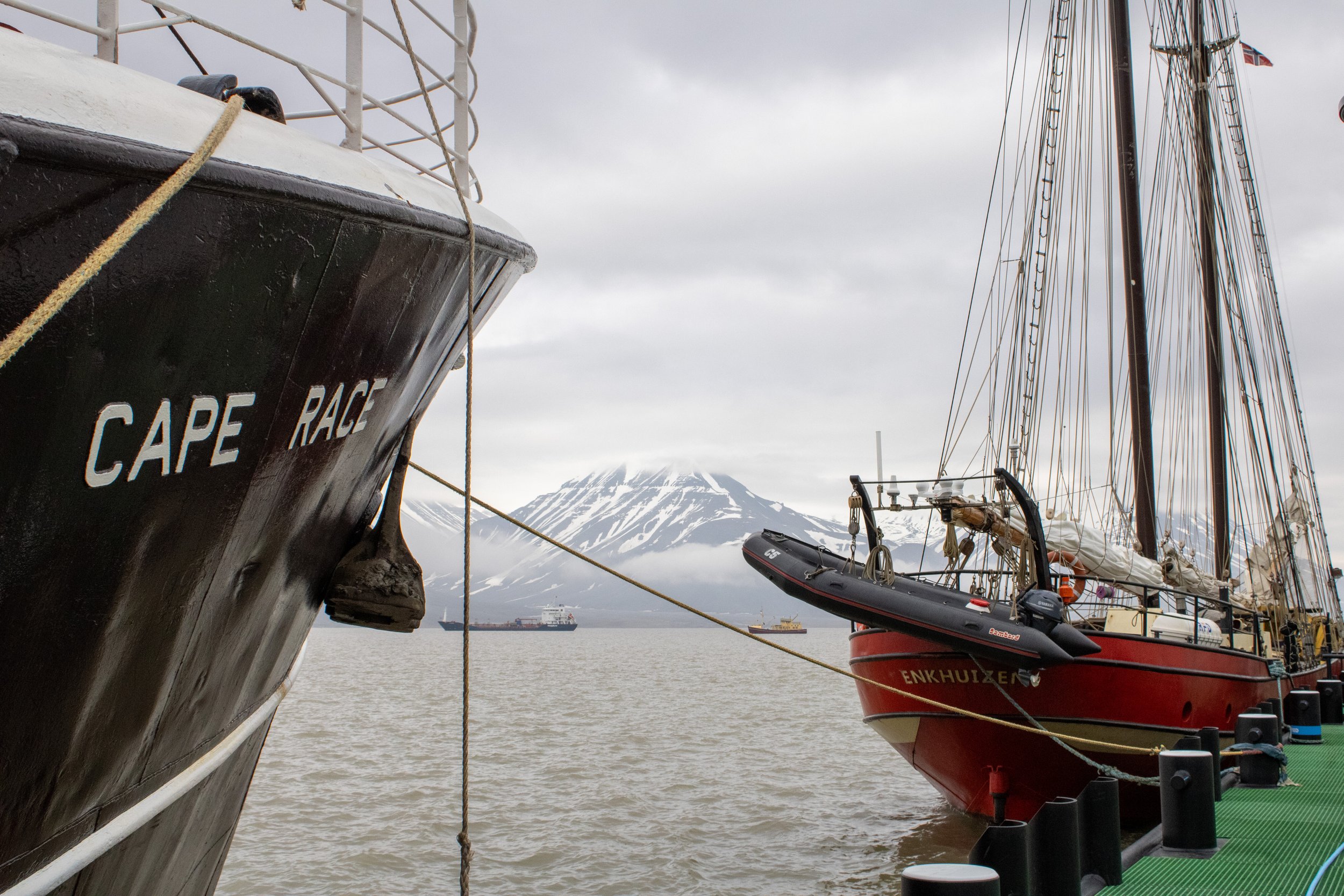
About to board the Cape Race
About an hour into our voyage we were treated to a breathtaking view of the mountains on the northern side of the Isjforden. I eagerly hastened outside to photograph the snowy peaks glinting in the misty sliver of sunlight. The scenery was mesmerizing. I once again felt as though we had ventured into some fairytale—the mountains even reminded me a bit of the movie depiction of Whoville. The pristine nature of it all reminded me of our first glimpses of Antarctica.

Our first treat to Svalbard’s immense beauty
I could already tell the top of the world would transform me the same way. While the similarities are noticeable, I knew there would be so much to learn, and so many more unique things to discover. The Earth cannot truly be described in all its glory. One must see it, experience it, themselves. When you do, you start to understand its miracle, the miracle of us, and all that we know within our beautiful home. Even at the top of the world, you know deep down, that you’re a part of it.

Full of light and life
Today is my wife’s birthday. I’ve never known a more beautiful loving person, and I couldn’t ask for a better partner. The passing of years has reinforced how vital relationships are. We are social beings that require companionship. The best advice I could offer anyone is to find another person to truly and completely share life with. Here’s to another year around the sun Angel. Thirty three and still fabulous!

Observing life in the hipster Grünerløkka district, Oslo, Norway
It can feel so good to be home. Svalbard was the longest trip we’ve done since 2020, and it felt so. Like it is for so many other things, travel is beneficial for evaluating one’s personal lifestyle setup. You’re given a fresh perspective of your life, almost that of a stranger, when you return from a long trip. Nothing is routine anymore, so you see your lifestyle more for as it truly is. How do you spend your time? Based on how you’re living, what do you value? Today I was pleased to find I was satisfied with the answers to those questions. Now, how will I continue to adapt and act on them? How will we strive to do so moving forward, together?

Leaving Norway and reflecting on the country’s beauty
Travel days going west are always shapeless. I leave at 11:30am local time in Oslo, and am scheduled to arrive at 6:30pm the same day, California time. It will be roughly 18 hours of traveling, compressed into one larger “day.”
These time travel journeys feel like a good time to decompress and reflect. Traveling can be stressful, but I try to think about the journey I just had, and consider all I’ve learned. Travel is only a great education if we remain open and thoughtful. It’s all too easy in today’s world of tours and convenience to snap photos of a destination, to claim you’ve “been there,” without actually visiting a place. Without experiencing all a region has to offer with all one’s senses. I can be just as guilty of it as anyone else at times.
Which is why I reflect on the journey homeward. To remember the tribulations along the way, to reminisce about the delicious food, the unique culture of the locals, and on a trip like this past one, to preserve in my mind’s eye the incredible nature of our planet. It’s a big beautiful amazing world, and part of traveling across it is to allow yourself to take it all in. When we truly appreciate whatever journeys we may take, we start to understand the whole miracle.

Looking back towards downtown Oslo from Bygdøy
Norway has been good to us. After visiting various parts of Oslo for a final time today, it’s time to say goodbye tomorrow morning. I enjoyed seeing this country’s incredible nature and wildlife, learning about its interesting history, and experiencing its unique culture. The Norwegian people are well educated, kind and eager to share about their homeland. Their cities are well run (I love the no cash system here) and efficient. This trip, although brief outside of our Svalbard expedition, offered a fun glimpse into a special part of the world that I had never been to, and hope to someday return. Takk Norge, until next time.

Peering down at the city below
Bergen felt completely different than Oslo and the rest of Norway (or at least the very limited parts we’ve visited). You could tell immediately it was a port town, the last bastion of civilization before open water for centuries of sailors. It was fascinating to learn its history as a German controlled harbor which brought fish and fish oil to the rest of Europe, to the early Norwegian capital, to its entryway to the interior fjords today. Bergen has lush green hills surrounding its position on the sea, charming homes dotting the hillsides in all directions, and character. You can feel the history here, the lives and endeavors of thousands of people who bartered and toiled and survived on the edge of this continent. Today’s experience served as a reminder of the progress we’ve made as a species and the beauty of our story, even the trials and tribulations.

Nærøyfjord this afternoon
We’re heading to Bergen, Oslo’s second largest city, on the train after a long day visiting Sognefjord. Norway’s public transit system is excellent, efficient and well coordinated. We’ve taken three trains, a bus, and a public ferry to get us from Oslo to the coast with a stop in Norway’s greatest fjord along the way.
Norway’s nature is simply beautiful. The mountains and valleys are dotted with picturesque villages comprised of clean elegant houses. There is snow on the ground in various places, while the landscape is covered with lakes, rivers and waterfalls. Sognefjord itself reminded me of Yosemite with more water. We glided past towering cliffs on either side that were littered with waterfalls. The countryside was idyllic, as if we were transported into a Scandinavian fantasyland.
I understand now why people claim Norway to be the most beautiful of the Nordic countries. Today I witnessed another example of Earth’s scale of majesty. There are so many places worth visiting, and Norway is one of them.

Oslo Opera House today
After a much later start due to a delayed flight, we got to explore Norway’s capital today for the first time. Oslo is a relatively small city, downtown being entirely walkable. It’s very orderly; people don’t cross the small streets when the pedestrian signal isn’t on, and trams and buses quietly whisk by at all times. There is history in its architecture, with modern buildings juxtaposed against cathedrals and theaters and government buildings from the 1600’s. One gets a sense for the entire country by walking around Oslo: Norwegian people are considerate, the country small, and the systems efficient. We hope to learn more over the next few days. Upon arrival, it’s clear there is much we can learn from this vibrant city.